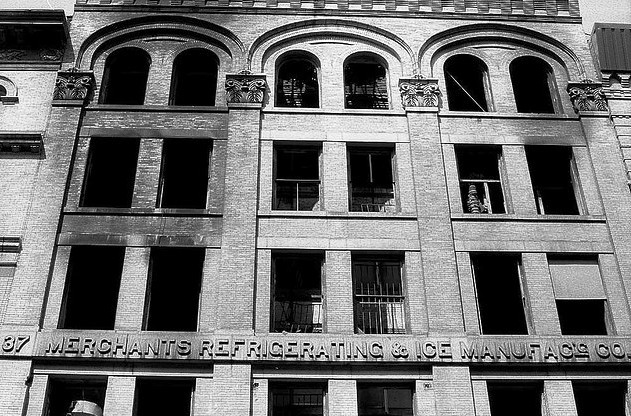 |
| photo by Alice Lum |
In the 19th and early 20th centuries before electric refrigeration would change the lives of American housewives, ice men hauled dripping blocks of ice on their shoulders up the stairs of apartment buildings where they would be deposited in oaken ice boxes.
If the lady of the house were lucky enough to have the luxury of an ice box.The ice came from manufacturing plants dotted around the city, some of which doubled as refrigerated storage warehouses for perishable foods. Among the most successful of New York City’s score of such firms was the Merchants Refrigerating and Ice Manufacturing Company. By the turn of the century Merchants Refrigerating was prosperous enough to warrant larger, more modern buildings.
In 1905 architect William H. Bickmire was commissioned to design a straight-forward brick industrial building as headquarters and warehouse for the firm at 35-37 North Moore. He produced a handsome five-story structure in the Romanesque style at the tail end of its popularity. Rough-cut limestone lintels and sills spanned pairs of windows between the brick pilasters that rose to support three graceful arches resting on ambitious, elaborate terra cotta Corinthian capitals.
 |
| photo by Alice Lum |
The building stretched through the block where the façade was duplicated at 30-32 Beach Street (later to be renamed Ericsson Place).
Most striking was the stone course that covered the entire width of the façade. In bold, carved sans serif letters the company’s name was emblazoned.Nearly a century earlier the neighborhood was one of refined Federal houses surrounding St. Johns Park; one of the most exclusive residential areas of the city. But in 1867 Trinity Church sold the park for $1 million to the Hudson River Railroad who built a freight depot on the site. And there went the neighborhood.
Within a matter of years the homes were gone and warehouses and factories, attracted by the convenience of the freight depot, replaced them. The Merchants Refrigerating & Ice Manufacturing Company was one of them.In September 1905, the year the building was completed, an ammonia tank exploded filling the structure with lethal gas. Firefighter James Calvery of Truck Company 8 was overcome and pulled nearly dead from the building by his fellow firemen. Because the fumes were too strong to allow anyone to repair the tank, firefighters ordered the engineer in charge to turn off the flow of ammonia.
The engineer refused, saying that there were thousands of dollars worth of perishable foods in the warehouse which would be ruined. Police shrugged their shoulders saying there was nothing they could do.Eventually the gases were pumped out of the building and the break repaired.
By 1918 the firm had obtained the United States Army contract for perishable provisions for the World War I soldiers. A new massive 11-story refrigerated warehouse near the Hudson River between 16th and 17th Street was constructed to handle the gargantuan quantities of food.By the time the Great Depression hit New York, Merchants Refrigerating had abandoned 35-37 North Moore for offices on Varick Street. Throughout the next few decades the building experienced a decline as did most of the aging structures in the area.
However as the Tribeca neighborhood was discovered by trendy restaurants and galleries in the 1980s, new hope arrived for the now-decrepit building.
 |
| By the 1990s, the building was not faring too well. -- Photo by Walter Grutchfield |
In 1995 New York Magazine reported on the renaissance. “Then there are the former warehouses at 31-37 North Moore Street in TriBeCa,” it said “where loft apartments will be sold as condominiums for $700,000 to $1.9 million. It’s very close to the entrance to the Holland Tunnel, but the neighborhood is home to David Letterman (when he sleeps in town), Bette Midler and John F. Kennedy Jr.”
Restoration architect Joseph Pell Lombardi was called in to do the renovation in 1998. Called “The Merchants House” the make-over joined four warehouses from 31 through 37 North Moore, resulting in 23 loft residences. New York Magazine’s property value estimates fell a little short when, within a few years of completion, apartments were selling for over $4 million.The sturdy warehouse with matching facades on two streets is a refreshing example of the trend in Manhattan of recycling vintage structures.
